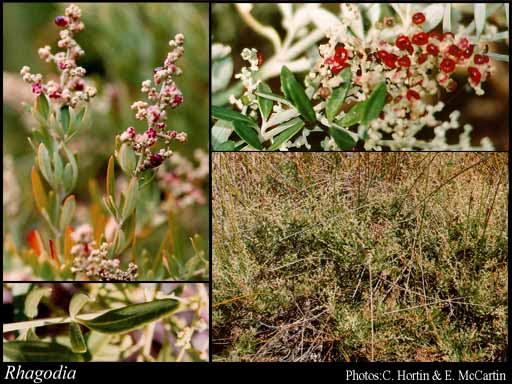- Reference
- Prodr.Fl.Nov.Holland. 408 (1810)
- Name Status
- Current

Scientific Description
Common name. Rhagodias. Family Chenopodiaceae.
Habit and leaf form. Shrubs, or herbs (rarely). Plants succulent, or non-succulent; spiny, or unarmed. The spines axial. Annual, or biennial, or perennial (often glaucous). Leaves cauline (ass.). Plants with a basal concentration of leaves, or with neither basal nor terminal concentrations of leaves. Stems not ‘jointed’. Young stems cylindrical (ass.). Stem internodes solid (ass.). Helophytic to xerophytic. Leaves minute to large; alternate, or opposite; spiral, or distichous; ‘herbaceous’, or fleshy; petiolate; simple; epulvinate. Leaf blades entire; flat, or rolled, or solid; sometimes terete, or semi-terete; linear, or elliptic, or obovate, or oblong; one-veined, or pinnately veined; hastate, or sagittate, or attenuate at the base, or rounded at the base. Leaves without stipules. Leaf blade margins entire. Leaves without a persistent basal meristem. Leaf anatomy. Hydathodes present, or absent. Hairs present (globular hairs may collapse to form a scurvy, silvery sheen).
Reproductive type, pollination. Fertile flowers hermaphrodite, or functionally male and functionally female, or functionally male, or functionally female. Unisexual flowers present, or absent. Plants hermaphrodite, or monoecious, or dioecious (predominately). Female flowers with staminodes, or without staminodes. Male flowers with pistillodes (pistillode minute).
Inflorescence and flower features. Flowers solitary (rarely), or aggregated in ‘inflorescences’; in cymes (in spike-like thyrse), or in fascicles (or clusters), or in panicles, or in glomerules. The terminal inflorescence unit cymose. Inflorescences terminal, or axillary. Flowers pedicellate (rarely), or sessile; bracteate (small, linear), or ebracteate; minute, or small; regular; cyclic. Hypogynous disk present (saucer- or cupshaped). Perianth sepaline; 5; 1 -whorled; joined (imbricate); fleshy, or non-fleshy; persistent; accrescent, or non-accrescent. Calyx present; not replaced by accrescent bracteoles; 5; gamosepalous; deeply blunt-lobed; imbricate; urceolate (to more or less globose); fleshy, or non-fleshy; persistent (in the fruit); accrescent, or non-accrescent. The fruiting calyx not berrylike; wingless, spineless and without tubercles. Calyx lobes obtuse, concave. Corolla absent. Fertile stamens present, or absent. Androecial members definite in number. Androecium 5. Androecial members free of the perianth, or adnate (to the base of the perianth); all equal (ass.); free of one another, or coherent (united at base into a disc which is puberulous or woolly inside or rarely glabrous); when coherent 1 - adelphous (connate at the base); 1 -whorled. Androecium exclusively of fertile stamens. Stamens 5; all more or less similar in shape (but vary from staminodes); isomerous with the perianth; alternisepalous. Anthers bent inwards in bud; dehiscing via longitudinal slits; tetrasporangiate. Fertile gynoecium present, or absent. Gynoecium (2–)5 carpelled. The pistil 1 celled. Gynoecium syncarpous; synovarious to synstylovarious; superior. Ovary unilocular; 1 locular; sessile (ass.). Gynoecium non-stylate, or stylate. Styles 2(–3); partially joined; apical (ass.). Stigmas 2. Placentation basal. Ovules in the single cavity 1; pendulous, or ascending; non-arillate; campylotropous.
Fruit and seed features. Fruit fleshy (viscous on drying); indehiscent; a berry; 1 celled. Gynoecia of adjoining flowers combining to form a multiple fruit, or not forming a multiple fruit. Fruit 1 seeded. Seeds more or less non-endospermic. Perisperm present. Cotyledons 2. Embryo curved (annular).
Etymology. From the Greek for "resembling berries or grapes".